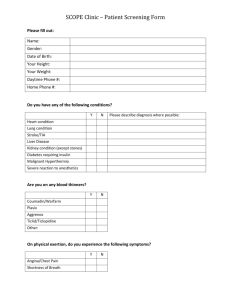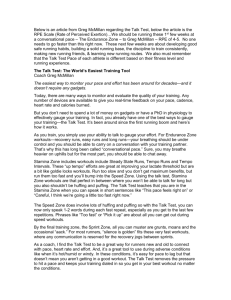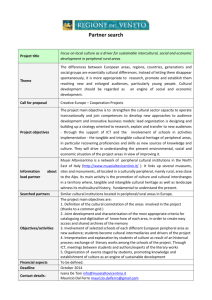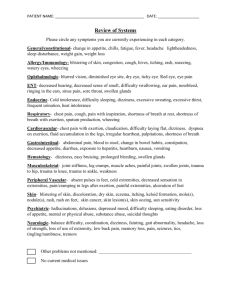Time course changes and physiological factors related to central
advertisement
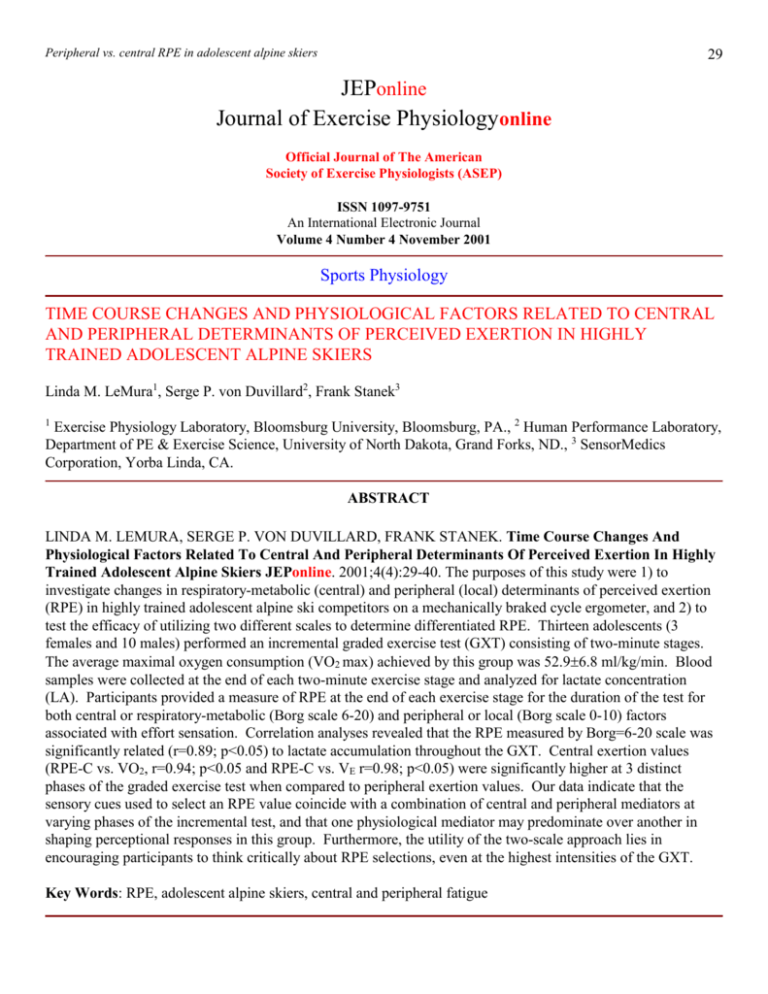
Peripheral vs. central RPE in adolescent alpine skiers 29 JEPonline Journal of Exercise Physiologyonline Official Journal of The American Society of Exercise Physiologists (ASEP) ISSN 1097-9751 An International Electronic Journal Volume 4 Number 4 November 2001 Sports Physiology TIME COURSE CHANGES AND PHYSIOLOGICAL FACTORS RELATED TO CENTRAL AND PERIPHERAL DETERMINANTS OF PERCEIVED EXERTION IN HIGHLY TRAINED ADOLESCENT ALPINE SKIERS Linda M. LeMura1, Serge P. von Duvillard2, Frank Stanek3 1 Exercise Physiology Laboratory, Bloomsburg University, Bloomsburg, PA., 2 Human Performance Laboratory, Department of PE & Exercise Science, University of North Dakota, Grand Forks, ND., 3 SensorMedics Corporation, Yorba Linda, CA. ABSTRACT LINDA M. LEMURA, SERGE P. VON DUVILLARD, FRANK STANEK. Time Course Changes And Physiological Factors Related To Central And Peripheral Determinants Of Perceived Exertion In Highly Trained Adolescent Alpine Skiers JEPonline. 2001;4(4):29-40. The purposes of this study were 1) to investigate changes in respiratory-metabolic (central) and peripheral (local) determinants of perceived exertion (RPE) in highly trained adolescent alpine ski competitors on a mechanically braked cycle ergometer, and 2) to test the efficacy of utilizing two different scales to determine differentiated RPE. Thirteen adolescents (3 females and 10 males) performed an incremental graded exercise test (GXT) consisting of two-minute stages. The average maximal oxygen consumption (VO2 max) achieved by this group was 52.96.8 ml/kg/min. Blood samples were collected at the end of each two-minute exercise stage and analyzed for lactate concentration (LA). Participants provided a measure of RPE at the end of each exercise stage for the duration of the test for both central or respiratory-metabolic (Borg scale 6-20) and peripheral or local (Borg scale 0-10) factors associated with effort sensation. Correlation analyses revealed that the RPE measured by Borg=6-20 scale was significantly related (r=0.89; p<0.05) to lactate accumulation throughout the GXT. Central exertion values (RPE-C vs. VO2, r=0.94; p<0.05 and RPE-C vs. VE r=0.98; p<0.05) were significantly higher at 3 distinct phases of the graded exercise test when compared to peripheral exertion values. Our data indicate that the sensory cues used to select an RPE value coincide with a combination of central and peripheral mediators at varying phases of the incremental test, and that one physiological mediator may predominate over another in shaping perceptional responses in this group. Furthermore, the utility of the two-scale approach lies in encouraging participants to think critically about RPE selections, even at the highest intensities of the GXT. Key Words: RPE, adolescent alpine skiers, central and peripheral fatigue Peripheral vs. central RPE in adolescent alpine skiers 30 INTRODUCTION There are physiological cues, both respiratory-metabolic (central) and peripheral (local) in origin, that act as stimuli to sensory perception. The original model of differentiated ratings of perceived exertion (RPE) proposed by Pandolf et al. (1), utilized a pyramidal format to categorize sensory events during dynamic exercise, which shape perceptual responses (Figure 1). The base of the pyramid contains physiological substrata, which mediate the intensity of exertional intolerance. The next level in ascending order contains discrete symptoms that originate in the physiological substrata. These discrete symptoms are grouped into exertion subclusters including cardiopulmonary (shortness of breath), leg (muscle aches) and general exertion (weariness). The subclusters form a primary, ordinate level of sensory processing labeled physical exertion. At the superordinate level, the primary clusters are integrated to generate an exertion index for the overall body. Figure 1: The levels of subjective reporting applicable to different types of physical exercise. Modified from Pandolf et al. (1). In adults, overall RPE selection is based upon the integration of cardiovascular, metabolic and localized sensations arising from the contracting skeletal muscles. To study the integration of sensory cues during exercise, researchers typically examine the relative contribution of central or respiratory-metabolic and peripheral or local cues in the determination of RPE. Examples of respiratory-metabolic signals of perceived exertion include ventilatory (VE) drive, oxygen consumption (VO2), carbon dioxide production (VCO2) and HR. The peripheral physiological mediators, which influence the intensity of perceptual signals arising from the exercising muscles in the limbs and torso, including lactate levels, may serve as an indirect marker of metabolic cues consistent with cellular acidosis. Aspects related to frequency and force of muscle activation along with associated proprioception are also important peripheral determinants of RPE (2). Research also indicates that the method of integration depends upon key variables such as the mode of exercise and the anatomical origin of differentiated signals, i.e. the arms, legs, shoulders and chest (3). The link between Peripheral vs. central RPE in adolescent alpine skiers 31 discreet symptoms and signal integration has been demonstrated most clearly during cycle ergometer exercise, where the differentiated signal from the legs is typically more dominant than from the chest or the overall signal (1,4). The end result of these experimental findings is that the dominant sensory signal should be identified separately for physical activities that vary in metabolic intensity, type, and the number of involved anatomical regions. While it is well established that in adults effort perception is a complex psychophysiological process that integrates all exertional symptoms, each of which is linked to an underlying physiological mediator (5), whether one physiological mediator predominates over another in shaping the perceptual response in younger subjects remains a topic of investigation (6). Research by Robertson and Noble (2) indicated that perceived exertion responses during dynamic exercise that are relatively consistent in adult populations are not always reproducible in children and adolescents. A more recent study revealed that young (mean age 10.9 years), untrained children experienced more pronounced cardiorespiratory and muscular sensations during a GXT on a cycle ergometer when compared to their adult counterparts (mean age 24.3 years). However, since the specific factors that are involved in RPE determination in highly trained adolescents are unknown, the primary purpose of this study was to examine the changes in respiratory-metabolic or central and local or peripheral RPE throughout the stages of an incremental exercise test in 13 to 18 year old participants. We hypothesized that the sport-specific conditioning of elite alpine skiers who are characterized by possessing above average leg power and strength (7,8) would influence the sensory integration process associated with effort perception. Thus, an understanding of how physiologic mediators relate to RPE selection in highly trained adolescents would significantly augment our understanding of the perceptual integration process in this group. The secondary purpose of this study was to examine the efficacy of utilizing two scales to identify the principle determinants of effort perception in adolescents: 1) the Borg RPE 6-20 scale (9) and 2) the Borg category ratio (CR) scale (10). The use of two scales during the same investigation was originally proposed by Borg and his colleagues (11) whereby correlation coefficients between the two scales during cycling, running and walking were found to lie between 0.997 and 0.999 in physically active adult men. They determined that the Borg RPE 6-20 and the CR scales are related to each other in a consistent way. Since this paradigm has not been investigated in younger participants, we aimed to demonstrate the efficacy and utility of this approach in discerning effort perception during an incremental exercise test. The complexity of contributory factors makes it extremely difficult to find a simple, reductionist explanation of the causes behind the perception of effort in all subjects, but particularly among young subjects. Therefore, our aim in the present investigation was to employ the two-scale paradigm in order to encourage adolescent participants to think critically about the physiological cues originating from the working muscles, joints and the organs of circulation and respiration. METHODS Participants Thirteen highly trained, competitive alpine skiers participated in this study (3 female, 10 male). The participants were (meanSD) 16.71.6 years old, 175.67.2 cm tall, and weighed 76.310.0 kilograms (kg). Percent (%) body fat was determined by the same individual trained in anthropometry. Seven skinfold sites (12) were assessed: (triceps, subscapular, midaxillary, chest, suprailiac, abdominal and thigh). The skinfold analysis resulted in a mean % body fat of 13.317.8 % (Table 1). The participants trained year round at the Stratton Mountain Ski Academy in Stratton, Vermont, and each was classified as a competitive alpine ski racer based on United State Ski Association National Point List. Parental permission and written informed consent were obtained in accordance with the guidelines established by the Institutional Review Board of the University of North Dakota. All testing occurred on the premises of the Stratton Mountain Ski Academy in Stratton, Vermont. Peripheral vs. central RPE in adolescent alpine skiers 32 Table 1: Physical characteristics of the subjects Subject Age (yrs) Gender VO2max (mL/kg/min) Height (cm) Weight (kg) Body fat (%) 1 2 3 4 5 6 7 8 9 10 11 12 13 MeanSD 18 18 18 18 18 16 15 18 17 16 15 17 13 16.91.6 M M M M M M M M M M F F F 60.9 44.6 44.0 51.6 42.7 56.2 53.2 55.7 53.2 66.6 54.8 55.1 49.0 52.86.7 185.4 181.6 185.4 172.7 175.3 176.5 172.7 175.3 177.8 180.3 165.1 175.3 160.02 175.67.2 78.2 82.3 93.2 80.5 86.4 64.5 76.4 76.4 88.2 72.7 60.9 70.5 61.8 76.310.0 7.3 7.8 11.0 10.2 12.3 5.3 11.7 11.2 10.8 6.5 22.7 30.1 26.1 13.37.8 Incremental Exercise Protocol Each participant performed a maximal incremental exercise ergometer test consisting of two-minute stages on a self-calibrating mechanically braked cycle ergometer (Monark, Model 814E). The initial load was set at 1.0 kg and increased by 0.5 kg every two minutes. The test was conducted at 60 rev/min. Most athletes were able to complete 7 to 8 stages (4.5-5.0 kg resistance) of the incremental workload test. Exercise intensity increased until maximal voluntary effort was attained. The test duration for all subjects ranged from 14 to 16 minutes. Data for pulmonary ventilation (VE BTPS, L/min), oxygen uptake (VO2, L/min), carbon dioxide production (VCO2, L/min) and respiratory exchange ratio (RER) were collected in breath-by-breath mode and subsequently averaged over each minute of exercise. Each participant's highest VO2 measure was considered the attainment of oxygen (VO2 max). Strong verbal encouragement was given to facilitate the best possible effort for each subject. The criteria for test termination, which were considered consistent with an exhaustive effort, included extreme fatigue, hyperpnea, and profuse sweating. Measurement Methods An open circuit spirometry metabolic cart (V-Max 29, SensorMedics Corporation, Yorba Linda, CA) was used to measure selected respiratory gas exchange measures for VE, VO2, VCO2, and RER. The electronic analyzers were calibrated before each test according to manufacturer guidelines. Heart rate (HR) was monitored continuously with a SensorMedics electrocardiograph (SensorMedics Corp. Yorba Linda, CA) that was integrated with the SensorMedics V-Max 29 System. The HR was recorded during the last 10 seconds of each stage of the GXT. Blood samples (25 L) were collected 10 seconds prior to the end of each stage by finger stick and analyzed for lactate (LA) via YSI 1500 lactate analyzer (Yellow Spring Corporation, Yellow Springs, Ohio). The YSI lactate analyzer was calibrated at the beginning of each individual GXT. Perceived Exertion Ratings of perceived exertion were assessed during the last 20 seconds of each minute of the GXT using both the Borg 6-20 point-category scale (9) and the category-ratio (CR-10) scale (13). The Borg category scale (620) has been validated extensively in the literature (14-16). Although there is precedence in the research literature for utilizing the 6-20 scale for both central and peripheral effort ratings, we postulated that the use of two scales would allow us to differentiate the relative contribution of one mechanism over another in this group Peripheral vs. central RPE in adolescent alpine skiers 33 of highly trained adolescent alpine skiers. In our study, the Borg 15-point scale was used to assess effort perception in the chest area only, while the CR-10 was used to assess effort perception (fatigue, pain) in the lower limbs. It has been established that the relationships between ratings of perceived exertion on the RPE 620 scale and ratings on the CR scale are highly significant for cycling, running and walking in active adults (11). Given the significant relationship that exists between the two scales, our rationale for the selection of the Borg 6-20 and the Borg CR in the present investigation was to avoid the potential replication of central and peripheral responses by the participants. By utilizing both scales, we aimed to strongly encourage the participants to concentrate on effort perception in one area of the body (i.e. the chest or the legs) at a time so that each area would be assessed independently. The Borg RPE scale (6-20) was used for determination of central factors because we wanted to ascertain the magnitude of estimation of work intensity. The Borg CR-10 ratio scale was used for the estimation of peripheral factors to measure the absolute sense of how hard these exercise intensities were perceived (10,17). The CR-10 was designed with ratio properties that allow for intermodel comparisons; therefore, the use of both scales allowed us to discern peripheral or local (RPE-P) and respiratory-metabolic or central (RPE-C) factor contributions. The order in which the scales were presented to the participants was randomized to prevent serial effects. Prior to testing, each participant received the following instructions regarding the assessment of the perception effort during the incremental test; “You are about to undergo an incremental cycle ergometer exercise test. You will be utilizing two scales during the test, which will allow us to assess your perceptions of exertion from two different areas of your body; namely, your chest and your legs. The first scale you see before you contains numbers from 6 to 20. The numbers on the scale represent a range of feelings from no exertion at all (number 6) to maximal exertion (number 20). It is important that your ratings of perceived exertion during exercise reflect the feelings of effort, discomfort, stress, and fatigue that are present in your chest area only. In other words, when we ask you to provide this rating, think about the following questions: Are you short of breath? Are you panting? Is it difficult to breathe? Can you feel your heart pounding? The number you point to on this scale that represents these feelings during your test will be referred to as the central or respiratory-metabolic rating of perceived exertion. We will ask you to provide this rating approximately every minute. The second scale you will see contains numbers from 0 to 10. The numbers on this scale represent a range of feelings of work intensity from nothing at all (0) to maximal (10). It is important that your ratings of perceived exertion during exercise reflect the feelings of effort, discomfort, stress, and fatigue that are present in your legs only. In other words, when we ask you to provide this rating, think about the following questions: Do you have any leg aches or cramps? Do you feel muscle tremors in your legs? Do your legs feel heavy or shaky? The number that you point to on the scale that represents these feelings will be referred to as the local or peripheral rating of perceived exertion. We will ask you to provide this rating either shortly before or shortly after you provide a rating for perceived exertion in your chest. In summary, you will be asked to give two ratings of perceived exertion at the end of every minute during the incremental test. Do your best to give each rating as accurately as possible. Use the verbal expressions to help you rate your feelings at that moment and give any number you feel is appropriate to describe your perception of exertion in either your legs or chest.” During the incremental test, the respiratory valve prohibited a verbal response; thus, the scales were positioned directly in front of the participants during the test so that a finger signal could be utilized. The blood measures were conducted immediately after both ratings were provided in order to prevent the possibility of a stress response from the blood draw. We requested only central and peripheral ratings in this study in order to pinpoint the potential contribution of one perceptual signal over another for overall ratings of perceived exertion. We deliberately avoided asking for a third or general rating of perceived exertion to avoid the possibility of overwhelming the subjects with quarries that might ultimately have clouded their ability to provide at least two highly accurate responses. Peripheral vs. central RPE in adolescent alpine skiers 34 Statistical Analyses Descriptive data were Table 2: Peak physiological variables of subjects. Values are meanSD calculated (MeanSD) for HR VE RER VO2 VCO2 LA the maximal physiological (b/min) (L/min) (L/min) (L/min) (mmol/L) variables generated by the MeanSD 191.55.0 140.629.3 1.090.1 4.030.5 4.50.6 12.52.9 incremental test including VO2, VE, RER, HR and LA. The selection of the two RPE scales to measure Table 3: F and p values for RPE-C and RPE-P by minute. Min RPE N F value p value exertional perceptions were a priori decisions designed to facilitate comparisons and interpretations RPE-C 6.1 13 1.00 0.33 1 of the test responses while simultaneously RPE-P 6.0 13 encouraging the participants to think critically about RPE-C 6.5 13 10.286 0.008* 2 their RPE selections. To that end, the CR-10 scale RPE-P 6.0 13 RPE-C 9.5 13 24.094 0.001* was adjusted with the Borg 6-20 scale in the 3 RPE-P 6.2 13 following manner: Numbers 0 through 4 on the CR RPE-C 8.1 13 0.0197 0.89 4 10 were coded as 0=6, 0.5=6, 1=7.5, 2=9.5, 3=11, RPE-P 8.0 13 and 4=12.5, respectively. The remaining portion of RPE-C 9.2 13 7.24 0.02* 5 the CR 10 scale (5 through 10) matched perfectly the RPE-P 8.1 13 remaining numbers of the Borg 6-20 scale (15 RPE-C 10.2 13 3.003 0.10 6 RPE-P 9.4 13 through 20). A repeated measures analysis of RPE-C 11.9 13 2.501 0.14 7 variance (RMANOVA) was used to assess RPE-P 11.2 13 differences between peripheral and respiratoryRPE-C 13.3 13 0.780 0.39 8 metabolic ratings of perceived exertion for each RPE-P 12.9 13 minute of the incremental test. An alpha level of RPE-C 14.4 11 0.132 0.72 9 RPE-P 14.2 11 0.05 was established a priori for all comparisons. A RPE-C 16.3 11 0.290 0.60 10 Pearson Product-Moment correlation was used to RPE-P 16.5 11 assess the relationship between the selected RPE-C 17.6 10 0.172 0.69 11 physiological variables and the RPE-C and RPE-P RPE-P 17.9 10 values. RPE-C 18.5 8 0.215 0.66 12 RESULTS The mean VO2 max achieved by this group was 52.96.8 mL/kg/min. All other peak physiological variables can be found in Table 2. The resultant F values and associated p values for each minute of the incremental exercise test are found in Table 3. The mean peak (SD) ratings of perceived exertion for both central and peripheral cues for each minute of the GXT are found in Figure 2. Significant differences (p<0.05) were found in minutes 2, 3 and 5 or during the first 3 stages of the testing protocol. A Pearson-Product Moment correlation analysis indicated that RPE-C responses were highly associated with VE (r=0.98; p<0.05), VCO2 (r=0.96; p<0.05), VO2 (r=0.94; p<0.05, and RER (r=0.79; p<0.05), respectively (Fig 3-6). RPE-P responses were highly related to [LA-] (r=0.85; p<0.05) and RER (r=0.77; p<0.05) (Fig 7-8). 13 14 RPE-P 18.2 RPE-C 19.5 RPE-P 19.4 RPE-C 19.8 RPE-P 19.8 8 8 8 5 5 0.179 0.69 0.00 1.00 Figure 2: RPE-C and RPE-P by minute of the incrementalload work protocol. Values are meanSD. Peripheral vs. central RPE in adolescent alpine skiers 35 DI SC US SI ON Figure 3: Relationship between RPE-C and pulmonary ventilation (VE BTPS) by stage. Values are expressed as meanSD. Figure 5: Relationship between RPE-C and oxygen consumption (VO2) by stage. Values are expressed as meanSD. Ek blo m and Gol dba rg (18 Figure 4: Relationship between RPE-C and carbon dioxide production (VCO2) production by stage. Values are expressed as meaSD. Figure 6: Relationship between RPE-C and respiratory exchange ratio (RER) by stage. Values are expressed as meanSD. ) were the first researchers to propose that the perception of effort during exercise was dependent on two factors; namely, peripheral factors related to feelings of strain in the joints, and respiratory-metabolic factors related to sensations from the cardiopulmonary system. They suggested further that the peripheral or local factors appeared to act as primary cues in RPE selection, and the central or respiratory-metabolic cues appeared to play a secondary role. Since this early investigation, numerous scientists from various countries have designed studies to evaluate the relative importance of various physiological cues underlying the perception of effort. Because the link between signal integration and RPE selection is clearly demonstrated during cycle ergometry, much of the research in this area has been conducted primarily utilizing this mode of exercise. During cycle ergometry, the sensory cues from the legs dominate those originating from the chest (3,4,19). Robertson et al. (20) used a cycle ergometer to demonstrate that when power output was held constant and pedal rate varied, the RPE ratings for the legs were always more intense than the arms rating (arms versus legs during leg exercise), and the undifferentiated rating for the overall body was a weighted average of the differentiated legs and chest ratings. The authors concluded that during cycling, peripheral signals from the Peripheral vs. central RPE in adolescent alpine skiers 36 lower limbs dominate the perceptual integration process. In further support of these findings, studies by Noble et al. (21) and Robertson et al. (20) demonstrated that during cycle ergometry, peripheral signals from the legs always dominated perceptual integration. Figure 7: Relationship between RPE-P and lactate concentration [LA-] by stage. Values are expressed as meanSD. Numerous investigators have examined perceptual integration and sensory dominance during prolonged exercise cycle ergometry (22), arm ergometry (23), and arm and leg ergometry (24). For those paradigms using arm ergometry only or arm and leg ergometry, the perceptual signals from the upper body were always dominant. In contrast, for paradigms involving leg cycle ergometry only, the legs rating was always more intense than the chest rating, thereby dominating perceptual integration. Furthermore, several reviews (25-27) which have evaluated the relative contribution of central and peripheral factor inputs in adults suggested that local sensory cues are usually perceived as dominant or primary. Our data indicate that in highly trained adolescent skiers, the relative contribution, and time course of central and peripheral cues shifts during an incremental exercise test. Figure 8: Relationship between RPE-P and respiratory During the early stages of the incremental test, that is, exchange ratio (RER) by stage. Values are expressed during the first 5 minutes or first 3 stages of the exercise as meanSD. protocol, our subjects reported that central signals dominated the sensory integration process as reflected by their RPE selection. Both the central and peripheral signals were not significantly different after the 5th minute of the incremental test. Therefore, as the test became increasingly intense, both central and peripheral signals contributed to shaping perceptual responses during maximal exercise. It is possible that the differences in effort perception during the early stages of the incremental test may be explained simply by the transition in the work rate from rest to exercise. In addition, interpretation of the meaningfulness of these data is complicated further by potentially low reliability of the scales at lower intensities (28). Thus, it is possible that the significant differences found at the low intensity end of the scales may be attributed to poor reliability rather than to a physiological influence. Notwithstanding these potential explanations, our findings are in contrast to those of Robertson (29) who reported that central signals of RPE serve as amplifiers in adults, which potentiate local cues relative to the aerobic demand. His data revealed that during the first 30 seconds of dynamic exercise, the exertional symptoms are entirely local in origin, and that the central sensory cues begin their effect on sensory integration after 30 to 180 seconds of exercise. Robertson's data corroborated the earlier work of Cafarelli et al. (3). Additionally, Robertson (29) indicated that the relative contribution of the central signals were limited when the metabolic intensity was less than 50% of VO2 max and significant only after reaching an intensity that was equal to or greater than 70% of VO2 max. The relative contribution of the peripheral signals, however, was dominant at all intensities. Our time course changes indicate that during the initial stages of the test, the central signals were significantly more intense than the peripheral signals. Correlation analyses revealed that the strongest associations existed between the RPE-C and VE, and RPE-C and VCO2. These associations appear to indicate that the participants Peripheral vs. central RPE in adolescent alpine skiers 37 experienced metabolic acidosis very early as demonstrated by the high LA- levels generated after only two minutes of the incremental test; however, the increased ventilatory drive during exercise most likely allowed for an adequate buffering response of the LA. The association between RPE-C and VCO2 most likely indicates that due to the intensity of the exercise, a greater ventilatory drive secondary to the increased demand for CO2 excretion intensified the central signal of perceived exertion. Not surprisingly, the relationship between RPE-P and LA- was quite strong (r=0.85). A substantial amount of experimental evidence supports blood LA concentration as an indirect marker of metabolic cues for perceived exertion (4,18,30). In our participants, LA was linked to the increase in peripheral RPE through its association with increased exercise intensity during the incremental test. It is interesting to speculate on the physiological mediators utilized by these highly trained adolescents who were able to generate a true (presence of the plateau criterion in all participants) VO2 max despite experiencing strong central signals very early on in the incremental test. These data appear to indicate that due to the intense nature of the physical training required to ski competitively on a national level, our participants were less likely to be affected by peripheral signals originating in the lower limbs than might be expected with age-matched, untrained control participants. This was despite being tested on the cycle ergometer. In their study of differentiated ratings of RPE in young children and adults, Mahon et al. (31) reported that the children's legs (peripheral) RPE were significantly higher than the chest (central) RPE during a GXT. Since children do not experience the same degree of metabolic acidosis as adults (32), they postulated that sensory mechanisms associated with the mechanical aspects of muscle activation accounted for the RPE differences. In contrast, our highly trained, adolescent skiers generated very high LA values; yet, at no time were peripheral sensory cues of RPE significantly higher than central sensory cues. In other words, the effort sensations that normally occur during the first 2 to 3 minutes of exercise that most individuals equate to increasing force (resistance) with effort (29) were not interpreted by our subjects as difficult. Rather, their state of training and the probable nature of their training adaptations altered the typical time course of central and peripheral sensory cues. Since we have no untrained control group to serve as a basis for physiologic comparison, we offer this as a potential explanation of our results. In support of this contention, studies conducted by von Duvillard and Knowles (8), and Bacharach and von Duvillard (33) indicated that in highly trained skiers, the lower extremities are significantly stronger and better trained than the age-matched, untrained population. Since our participants can be characterized as highly trained adolescent skiers, it follows that the relative contribution of local and central sensory cues for the overall perceptual integration process would shift during the incremental test as the intensity of the test progressed, with a greater central cue beginning early during exercise, followed by strong sensory cues that are both central and peripheral. In short, the process of shaping the perceptual process in these highly trained adolescent skiers evolved from predominately central to a combination of both central and peripheral and cues during dynamic exercise. The secondary purpose of this study was to examine the efficacy of utilizing two RPE scales during the incremental test with this group of adolescent, highly trained alpine skiers. We observed that our participants thought carefully about their choices of effort perception, even at the highest intensities of the test protocol. Although it is questionable if this research paradigm would be useful with even younger children, we believe that the differential scale approach requires further investigation in a wide range of trained and untrained individuals. Additional study of the two-scale approach would substantiate further the external as well as internal validity of this method for the purpose of discerning differential ratings of perceived exertion during exercise. In summary, the results of this study indicate that the factors involved in RPE determination in highly trained adolescent skiers are not consistent with those identified in the literature. In particular, our participants were not affected by the utilization of cycle ergometry that is known to generate consistently higher RPE-P ratings, in the Peripheral vs. central RPE in adolescent alpine skiers 38 same manner. Rather, the time course changes of central and peripheral responses in the participants in our study revealed higher RPE-C ratings early on in the incremental test. These differences abated after the first five minutes of exercise. We attribute these findings to the intense nature of our participants' routine training as well as their current conditioning status. Additional studies with individuals in this age group are required to determine how RPE selection varies in trained and untrained individuals. Future studies should be directed toward the effects of different exercise protocols as well as the efficacy two-scale paradigm to understand further, how the process of sensory integration develops during dynamic exercise. ACKNOWLEDGEMENTS The authors would like to thank the athletes of the Stratton Mountain Ski Academy for their participation in this study. We would especially like to acknowledge the efforts of the Head Alpine Ski Coach Mr. Pavel Stastny for inviting us to routinely measure physiological variables and parameters on a yearly basis. This research was supported, in part, by a Research and Disciplinary Grant from Bloomsburg University. There were no financial conflicts of interest related to this research. Address for correspondence: Serge P. von Duvillard, Ph.D., Professor and Director-Human Performance Laboratory, Department of Physical Education and Exercise Science, University of North Dakota, Grand Forks, ND 58202-8235 ; Phone: (701) 777-4351 ; Fax: (701) 777-3531 ; e-mail: serge_vonduvillard@und.nodak.edu REFERENCES 1. Pandolf, K.B., Burse, R. L., & Goldman, R. F. (1975). Differentiated ratings of perceived exertion during physical conditioning of older individuals using leg-weight loading. Perceptual Motor Skills 40:563-574. 2. Robertson, R. J., and Noble B. J. (1997). Perception of Physical Exertion: Methods, Mediators, and Applications. In Exercise and Sports Science Reviews, Williams and Wilkins and 25:407-441. 3. Cafarelli, E., Cain W. S., and Stevens J. C. (1977). Effort of dynamic exercise: Influence of load duration and task. Ergonomics 20:147-158. 4. Gamberale, F. (1972). Perception of exertion, heart rate, oxygen uptake, and blood lactate in different work operations. Ergonomics 15:545-554. 5. Robertson, R. J., Falkel, J. E., Drash, A. L., Swank, A. M., Metz, K. F., Spungen, A., & LeBoeuf, J. R. (1986). Effect of blood pH on peripheral and central signals of perceived exertion. Med Sci Sports Exerc 18:114-122. 6. Mahon, A.D. and Ray, M.(1995). Ratings of perceived exertion at maximal exercise in children performing different graded exercise test. J Sports Med Phys Fit 35:38-42. 7. Karlsson, J. (1984). Profiles of cross-country and alpine skiers. Clinics in Sports Medicine Vol. 3, No. 1, pp 245-271. 8. Von Duvillard, S. P. and W. Knowles (1997). Relationship of anaerobic performance tests to competitive alpine skiing events. In Science and Skiing (E. Müller, H. Schwameder, E. Kornexl, C. Raschner, Eds) E & FN Spon, Chapman and Hall Publishers, London, UK, pp 297-308, 1997. 9. Borg, G. (1970). Perceived exertion as an indicator of somatic stress. Scand J Rehab Med 2:92-98. 10. Borg, G. A. (1982). A category scale with ratio properties for intermodal and interindividual comparisons. In Psychophysical judgment and the process of perception, ed. H. Geissler and P. Petzold, 25-34. VEB Deutscher Verlag der Wissenschaften. 11. Borg, G., Van Den Burg, M., Hassmen, P., Kaijser, L. And Tanaka, S. (1987). Relationships between perceived exertion, HR and HLa in cycling, running and walking. Scandin J Sports Sci 9(3): 69-77. 12. Jackson, A. S., and M. L. Pollock (1985). Practical assessment of body composition. Physic Sports Med Peripheral vs. central RPE in adolescent alpine skiers 39 13:77-90. 13. Borg, G., Holmgren A, and Lindblad I. (1981). Quantitative evaluation of chest pain. Acta Medica Scandinavia (Suppl 644) :43-45. 14. Borg, G. A. (1978). Psychological assessment of physical effort. In Proceedings of the 1978 International Symposium on Psychological Assessment in Sport, 49-57. Netanya, Israel. Wingate Institute for Physical Education and Sport. 15. Skinner, J. S., Hustler, R., Bergsteinova, V., & Buskirk, E. R. (1973). The validity and reliability of rating scale of perceived exertion. Med Sci Sports 5:97-103. 16. Stamford, B. A. (1976). Validity and reliability of subjective ratings of perceived exertion during work. Ergonomics 19:53-60. 17. Borg, G. A. (1982). Psychophysical basis of perceived exertion. Med Sci Sports Exerc 14:377-381. 18. Ekblom, B., and Goldbarg A. N. (1971). The influence of physical training and other factors on the subjective rating of perceived exertion. Acta Physiologica Scandinavica 83:399-406. 19. Ekblom, B., Lovgren O., Alderin M., Fridstrom M., and Satterstrom G. (1975). Effect of short-term physical training on patients with rheumatoid arthritis: Scandin J Rheumatology 4:80-86. 20. Robertson, R., Gillespie, R., Hiatt, E., & K. Rose, K. (1977). Perceived exertion and stimulus intensity modulation. Perceptual Motor Skills 45:211-218. 21. Noble, B.J., Kraemer, W. J., Allen, J. G., Plank, J. S. & Woodard L. A. (1986). The integration of physiological cues in effort perception: Stimulus strength vs. Relative contribution. G. Borg and D. Ottoson (eds.). The Perception of Exertion in Physical Work. London: Macmillan. pp.83-96. 22. Kang, J., Robertson, R. J., Goss, F. L., DaSilva, S. G., Visich, P., Suminski, R. R., Utter, A. C., & Denys B. G (1996). Effects of carbohydrate substrate availability on ratings of perceived exertion during prolonged exercise of moderate intensity. Perceptual Motor Skills 82:495-506. 23. Robertson, R. J., Goss, F. L., Auble, T. E., Spina, R., Cassinelli, D., Glickman, E., Galbreath R., & Metz, K. (1990). Cross-modal exercise prescription at absolute and relative oxygen uptake using perceived exertion. Med Sci Sports Exerc 22:653-659. 24. Pandolf, K.B., Billings, D. S., Drolet, L. L., Pimental, N. A., & M.N. Sawka, M. N. (1984). Differentiated ratings of perceived exertion and various physiological responses during prolonged upper and lower body exercise. Eur J Appl Physiol 53:5-11. 25. Cafarelli, E. (1978). Effect of contraction frequency on effort sensations during cycling at a constant resistance. Med Sci Sports 10:270-275. 26. Mihevic. P.M., Gliner, J. A., & Horvath S. M.(1981). Perception of effort and respiratory sensitivity during exposure to ozone. Ergonomics 24:365-374. 27. Pandolf, K.B. (1978). Influence of local and central factors in dominating rated perceived exertion during physical work. Perceptual Motor Skills 46:683-698. 28. Lamb, K.L (1995). Children's ratings of effort during cycle ergometry" an examination of the validity of two effort ratings scales. Pediatric Exercise Science 7:407-421. 29. Robertson, R.J. (1982). Central signals of perceived exertion during dynamic exercise. Med Sci Sports Exerc 14:390-396. 30. Noble, B.J., Borg, G., Jacobs, I., Ceci, R. & Kaiser, P. (1983). A category-ratio perceived exertion scale: relationship to blood and muscle lactates and heart rate. Med Sci Sports Exerc 14:406-411. 31. Mahon, A.D., Gay, J.A. and Stolen, K.Q. (1998). Differentiated ratings of perceived exertion at ventilatory threshold in children and adults. Eur Journal Appli Physiol 18:115-120. 32. Bar-Or, O. (1983). Pediatric sports medicine for the practioner. Springer-Verlag, New York, pp. 255-266. 33. Bacharach D. W. and Von Duvillard, S.P. (1995). Intermediate and long-term anaerobic performance of elite alpine skiers. Med Sci Sports Exerc 3:305-309.

